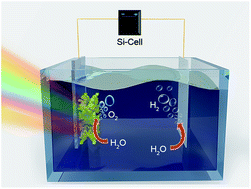An in situ combustion method for scale-up fabrication of BiVO4 photoanodes with enhanced long-term photostability for unassisted solar water splitting†
Abstract
The development of large-area, low-cost photoanodes with high efficiency and photostability is pivotal for the commercialization of photoelectrochemical (PEC) water splitting. Here, an in situ combustion process is reported as a new route to the solution growth of bismuth vanadate (BiVO4) photoanodes. The highly exothermal in situ combustion process ignites rapid solvent evaporation and promotes the homogeneous distribution of BiVO4 on large-size conductive substrates. Also, the released thermal energy builds tight connection between the BiVO4 films and the conductive substrates, which suppresses the cathodic photocorrosion and shows unexpected high photocurrent density and ultralong photostability. The as-formed photoanodes can continuously work for sulfite oxidation under consecutive AM 1.5G illumination for ∼190 h with no decay, and for water oxidation for ∼135 h with ∼20% performance decay compared with the initial value. Such a high photostability toward water oxidation has not been reported for large-size BiVO4 photoanodes previously. A PEC-PV device is fabricated by assembling 9 pieces of combustion-processed large size (25 cm2) BiVO4 photoanodes for unassisted solar water splitting. The as-assembled device shows a stable photocurrent of up to 0.26 A even after working for 40 sunny days under real solar light irradiation (1 h for each day). Such a facile in situ solution combustion method is promising for scale-up fabrication of large size BiVO4 photoanodes, and it can also potentially be implemented to fabricate other types of photoelectrodes on conductive substrates and promote their large-scale deployment.



 Please wait while we load your content...
Please wait while we load your content...